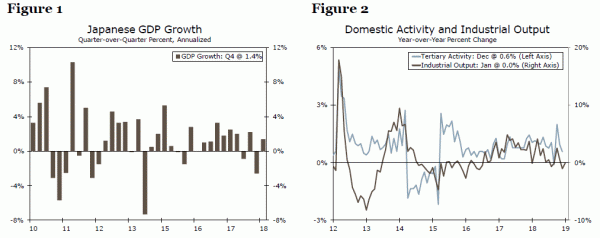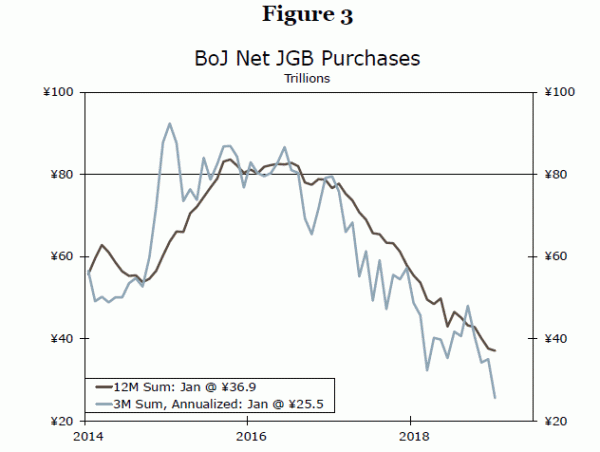Executive Summary
After a period of steady growth, Japan’s economy has slowed more recently. The economy experienced up-and-down growth in 2018, while inflation still remains well below the central bank’s target. That sluggish momentum has carried into 2019, with activity indicators suggesting economic growth is likely to remain subdued, while an increase in the consumption tax this year should also weigh on the economy. As the economic outlook remains underwhelming, along with a more dovish tone from other central banks, we no longer expect the Bank of Japan (BoJ) to tighten monetary policy in Q2-2019. Despite our forecast policy change, we believe the path for the yen remains relatively unchanged. At this time, we still expect modest gains in the yen over the mediumterm as the Fed becomes less hawkish and the U.S. dollar shows broad-based softness, while residual volatility could also support the yen given its safe-haven status.
Japan Returns to Stop-Start Economic Growth
After a period of sustained economic growth in 2016 and 2017, when Japan’s economy expanded for eight quarters in a row, activity returned to a more familiar stop-start pattern in 2018. On a sequential basis, Japan’s GDP has contracted in two of the past four quarters, with a large 2.6% quarter-over-quarter annualized decline in the third quarter, only partially recovered by the 1.4% increase in the fourth quarter (Figure 1). Looking through the details, consumer spending and domestic demand remained reasonably steady, with weakness instead concentrated in a decline in government investment spending and a negative contribution from net exports.
Monthly activity data confirm this subdued picture of Japanese growth, albeit with the service sector somewhat steadier than the manufacturing sector. Service sector output fell in both November and December and registered a gain of just 0.6% year-over-year in the final month of 2018. Meanwhile, industrial output has showed an overall slowing trend over the past several months, and was flat year-over-year in January (Figure 2). Finally we note that the Bank of Japan (BoJ) remains well short of its medium-term 2% inflation goal. In January the CPI excluding fresh food rose 0.8% year-over-year, although that figure was boosted by higher energy prices. The headline CPI rose just 0.2% year-over-year, down from 0.3% a month prior.
This underwhelming performance of the Japanese economy has, in our opinion, important implications for BoJ policy, as well as being an influence for the path of the Japanese yen. In mid-2018, the BoJ adjusted its tolerance around its 10-year government yield target of “around zero percent”, allowing a tolerance of +/-20 basis points. At that time, Japan’s economy was growing reasonably steadily, the outlook was for an ongoing rise in global bond yields, and Japanese authorities were perhaps also seeking to improve the functioning of the Japanese government bond (JGB) market. We had expected further adjustment to BoJ monetary policy this year. Specifically, we expected the central bank to raise its policy rate from -0.10% to 0.00%, and to widen the tolerance band for JGB yields during the second quarter of this year.
Fast forward, however, and the outlook in Q1-2019 is noticeably different from that of mid-2018. Upward pressure on global yields has lessened, with the Fed taking a less hawkish stance, while the European Central Bank and the Bank of England continue to move only gradually in the direction of policy normalization. Meanwhile, government bond yields have generally reversed course, with two and 10-year Treasury yields falling markedly over the past few months. Hence the upward pressure on Japanese yields has also dissipated. In addition, subdued Japanese data in our view has altered the balance between adjusting policies aimed at improving market functioning, versus maintaining accommodative monetary policy to support the economy.
We also expect the increase in Japan’s consumption tax from 8% to 10%, scheduled for October 1 this year, to proceed as planned. With that planned consumption tax increase now approaching more quickly we believe the window for a central bank policy adjustment has likely closed. We no longer expect the BoJ to adjust monetary policy in the second quarter, or indeed during all of 2019.
What Doesn’t Go Up, Doesn’t Come Down
We believe recent dovish comments from BoJ policymakers are consistent with our revised outlook for no change in central bank policy. Specifically, speaking to Parliament, Governor Kuroda said that should the yen’s exchange rate impact Japan’s economy and prices, the BoJ may consider additional easing, potentially including lowering yields or buying assets. Kuroda also mentioned the central bank would carefully consider the benefits and costs of additional easing. Of course “carefully considering” is not the same as “following through” and we do not believe the BoJ will shift policy in either a less accommodative or a more accommodative direction at this time
If the BoJ were to tweak policy in a more accommodative direction, perhaps the most likely policy lever to adjust would be to ramp up its bond purchases, which have been scaled back noticeably over the past several quarters (Figure 3), with net JGB purchases slowing to just ¥37 trillion over the past 12 months. However, even quickening the central bank’s bond purchases does not come without some technical challenges. Given its large scale asset purchases over the past few years, by late 2018 the BoJ already held around 46% of outstanding government bonds, a potential headwind to just how quickly the central bank could (or would want to) ramp up bond purchases again.
Steady Bank of Japan, Slightly Stronger Yen
The shift in our outlook for BoJ policy has been matched by the shift in our outlook for Federal Reserve policy over the past several months. As a result of a more dovish Fed, we now expect only one Fed rate hike in 2019. Indeed, with little action from the BoJ, it will likely be swings in Federal Reserve monetary policy outlook that will be influential for the dollar/yen exchange rate. Even with the change to our Japanese central bank outlook, our view of the yen’s prospects versus the U.S. dollar is little changed, as we still expect the yen to gain moderately against the greenback over the medium-term. One other factor that could have some influence on the USD/JPY exchange rate would be any ongoing market volatility and resulting safe haven support for the yen. While there will likely be episodes of volatility during 2019, some market and event risks appear to be moving in a more favorable direction. For example, U.S.-China trade discussions appear to be moving in a more constructive direction, while we ultimately believe a Brexit deal will be struck between the United Kingdom and the European Union. We believe a less volatile market backdrop could limit the extent of those yen gains.















